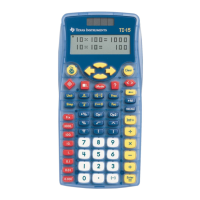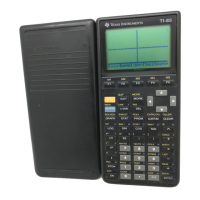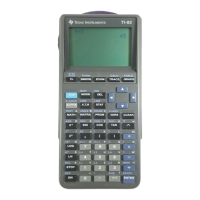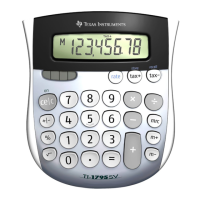Using Lists & Spreadsheet 575
• correlation coefficient, R.
Linear Regression (mx+b) (LinRegMx) fits the model equation
y=ax+b to the data using a least-squares fit. It displays values for m (slope)
and b (y-intercept).
Linear Regression (a+bx) (LinRegBx) fits the model equation
y=a+bx to the data using a least-squares fit. It displays values for
a
(y-intercept),
b (slope), r
2
, and r.
Median-Median Line (MedMed) fits the model equation y=mx+b
to the data using the median-median line (resistant line) technique,
calculating the summary points x1, y1, x2, y2, x3, and y3.
Median-Median Line displays values for m (slope) and b (y-intercept).
Quadratic Regression (QuadReg) fits the second-degree
polynomial y=ax
2
+bx+c to the data. It displays values for a, b, c, and R
2
.
For three data points, the equation is a polynomial fit; for four or more,
it is a polynomial regression. At least three data points are required.
Cubic Regression (CubicReg) fits the third-degree polynomial
y=ax
3
+bx
2
+cx+d to the data. It displays values for a, b, c, d, and R
2
. For
four points, the equation is a polynomial fit; for five or more, it is a
polynomial regression. At least four points are required.
Quartic Regression (QuartReg) fits the fourth-degree polynomial
y=ax
4
+bx
3
+cx
2
+dx+e to the data. It displays values for a, b, c, d, e, and
R
2
. For five points, the equation is a polynomial fit; for six or more, it is a
polynomial regression. At least five points are required.
Power Regression (PowerReg) fits the model equation y=ax
b
to
the data using a least-squares fit on transformed values ln(x) and ln(y). It
displays values for
a, b, r
2
, and r.
Exponential Regression (ExpReg) fits the model equation y=ab
x
to
the data using a least-squares fit on transformed values x and ln(y). It
displays values for
a, b, r
2
, and r.
Logarithmic Regression (LogReg) fits the model equation
y=a+b ln(x) to the data using a least-squares fit on transformed values
ln(x) and y. It displays values for
a, b, r
2
, and r.
Sinusoidal Regression (SinReg) fits the model equation
y=a sin(bx+c)+d to the data using an iterative least-squares fit. It displays
values for
a, b, c, and d. At least four data points are required. At least
two data points per cycle are required in order to avoid aliased frequency
estimates.

